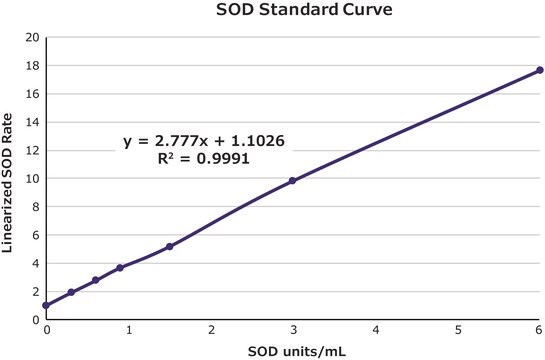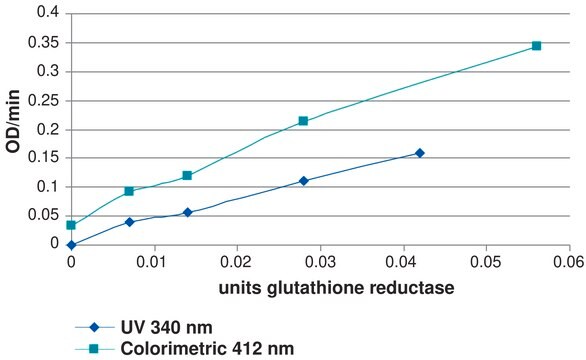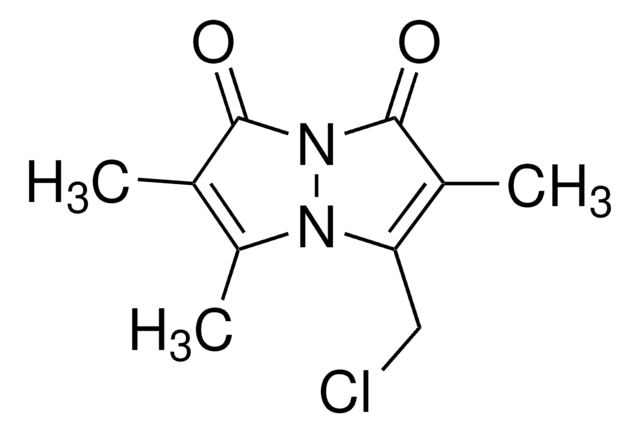354102
Glutathione Assay Kit
About This Item
Produits recommandés
Utilisation
sufficient for 100 tests
Niveau de qualité
Fabricant/nom de marque
Calbiochem®
Conditions de stockage
do not freeze
protect from light
assay range
sensitivity: 5.0 μM
(RSH)
Entrée
sample type cell lysate
sample type cell lysate
sample type tissue homogenate(s)
sample type tissue homogenate(s)
Méthode de détection
colorimetric
Conditions d'expédition
wet ice
Température de stockage
2-8°C
Description générale
Composants
Avertissement
Caractéristiques
Principe
Notes préparatoires
1. Centrifuge a minimum of 500 l of whole blood at 2500 X g at 4°C for 5 min.
2. Discard plasma supernatant. If not assayed immediately, store erythrocyte pellet at -70°C (erythrocyte pellet can be stored at -70°C for 15 days).
3. Resuspend erythrocyte pellet in 4 volumes of MPA working solution, 0-4°C.
4. Thoroughly mix and centrifuge at 3000g at 4°C for 10 min.
5. Collect the upper clear aqueous layer and keep at 0-4°C for the assay (within 1 h).
Liver Homogenates
1. Wash tissue in 0.9% NaCl solution.
2. Blot tissue on paper and weigh.
3. Mince tissue in ice-cold MPA working solution.
4. Homogenize minced tissue.
5. Centrifuge homogenate at 3000 x g, 4°C for 10 min.
6. Collect the upper clear aqueous layer* and keep at 0-4°C for the assay (within 1 h).
*Cloudy supernatant should be filtered through 0.2 m filters.
Hepatocyte Lysates
1. Resuspend hepatocyte* pellet, from rats or mice, in 500 l of ice-cold MPA working solution.
2. Homogenize cell suspension.
3. Centrifuge homogenate at 3000 x g, 4°C for 10 min.
4. Collect the upper clear aqeous layer and keep at 0-4°C for the assay (within 1 h).
*Approximately 2.5-3.5 x 106 cells are used (5-8 mg of total protein).
Stockage et stabilité
• All solutions of reagents and buffer have been tightly sealed and are stable if properly stored between 4°C. Do Not Freeze. Protect from light.
• After removing the required amount of each reagent for immediate use, all bottles should be tightly closed and stored between 2-4°C. Do not leave the reagent bottles open or at room temperature.
Remarque sur l'analyse
The Calbiochem Glutathione Assay Kit can be used for the measurement of other mercaptans (RSH), which include GSH. The assay is carried out in the absence of reagent R2 at 356 nm. The absorbance at 356 nm is a linear function of [RSH] concentration in the sample, but it is not GSH-specific. If the sample essentially contains GSH and a single other mercaptan i.e., N-acetylcysteine, these two mercaptans can be assayed by using the same single sample for two measurements. The first measurement is made at 356 nm before the addition of reagent R2 as described below, and the second measurement is made, after the addition of R2, at 400 nm.
Adjust the spectrophotometer absorbance to zero at 356 nm with buffer only (solution 3). The reaction mixture is prepared as in Section 3, with the omission of step 4. The absorbance (A) is measured at 356 nm.
A standard curve must be prepared with the corresponding mercaptan in Table 2, to calculate the concentration. Figure 2 gives two examples of standard curves obtained with glutathione and Nacetylcysteine at 356 nm.
GSH Concentration
The calculation is based on the following equation:
[GSH] = {(A-A0)/(E x l)} x D
where:
[GSH] is the initial glutathione concentration in the sample, expressed as molar concentration.
A and A0 are the absorbances measured in the presence and in the absence of sample, respectively.
E is the apparent molar extinction coefficient of the product measured at 400 nm.
l is the optical path (cm).
D is the dilution factor of the sample.
Total Mercaptan Concentration
The calculation is based on the modified version of the equation used for GSH:
[total RSH] = { (A - A0) / (E x I) } x D
where :
[total RSH] is the concentration of total mercaptan in the sample.
A and A0 are the absorbances measured in the presence and in the absence of sample, respectively.
E is the apparent molar extinction coefficient of the product measured at 356 nm.
I is the optical path (cm).
D is the dilution factor of the sample.
Note:
- Do not add reagents R1 and R2 in reverse order.
- The temperature, (25 ± 3°C), should be kept constant throughout the experiment.
- The final reaction volume (1 ml) should not vary from one measurement to another.
- The absorbance at 400 nm is proportional to glutathione concentration. It is stable for min, provided that the reaction mixture is kept in the dark.
- The sensitivity of the assay for mercaptans at 356 nm is of the same order of magnitude as that of glutathione at 400 nm as shown in Table 2.
Autres remarques
Anderson M.E. 1989. Enzymatic and chemical methods for the determination of
Glutathione; In: Glutathione: chemical, biochemical and medical aspects, Vol. A, Dolphin D., Poulson R. and Avramovic O. Eds., John Wiley and Sons, pp. 339-365.
Dolphin D., et al. 1989. Glutathione: Chemical, Biochemical and Medical Aspects, Vols A & B, J. Wiley and Sons.
Informations légales
Mention d'avertissement
Danger
Mentions de danger
Classification des risques
Eye Dam. 1 - Met. Corr. 1 - Skin Corr. 1A
Code de la classe de stockage
8B - Non-combustible corrosive hazardous materials
Point d'éclair (°F)
Not applicable
Point d'éclair (°C)
Not applicable
Certificats d'analyse (COA)
Recherchez un Certificats d'analyse (COA) en saisissant le numéro de lot du produit. Les numéros de lot figurent sur l'étiquette du produit après les mots "Lot" ou "Batch".
Déjà en possession de ce produit ?
Retrouvez la documentation relative aux produits que vous avez récemment achetés dans la Bibliothèque de documents.
Les clients ont également consulté
Notre équipe de scientifiques dispose d'une expérience dans tous les secteurs de la recherche, notamment en sciences de la vie, science des matériaux, synthèse chimique, chromatographie, analyse et dans de nombreux autres domaines..
Contacter notre Service technique





